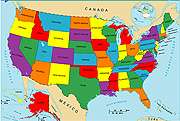States lagging in emergency preparedness, report shows

(HealthDay)—While significant progress has been made in the past 10 years, many states still fall short in their preparedness for public health emergencies such as disease outbreaks, natural disasters and bioterrorist attacks, according to a new report.
It found that 35 states and Washington, D.C. scored 6 or lower on 10 key indicators of public health preparedness. Kansas and Montana scored lowest—3 of 10—while Maryland, Mississippi, North Carolina, Vermont and Wisconsin scored highest, with 8 of 10.
The scores of other states were:
- Score of 7: Alabama, Arkansas, California, Delaware, Nebraska, New Hampshire, New Mexico, New York, North Dakota and Virginia.
- Score of 6: Connecticut, Idaho, Iowa, Kentucky, Louisiana, Maine, Massachusetts, Missouri, Ohio, Oklahoma, South Carolina, Tennessee, Utah, Washington and Wyoming.
- Score of 5: Alaska, Arizona, Washington, D.C., Florida, Illinois, Indiana, Michigan, Minnesota, Oregon, Pennsylvania, Rhode Island, South Dakota, Texas and West Virginia.
- Score of 4: Colorado, Georgia, Hawaii, Nevada and New Jersey.
Among the key findings:
- 29 states cut public health funding from fiscal years 2010-2011 to 2011-2012, with 23 of these states cutting funds for a second year in a row and 14 for three consecutive years.
- Federal funds for state and local preparedness have decreased 38 percent from 2005 to 2012. States report that gains in public health preparedness achieved since Sept. 11, 2001, are eroding, and that budget cuts since 2008 have resulted in more than 45,700 job losses at state and local health departments.
- Two states alone have met the national goal of vaccinating 90 percent of young children, ages 19 to 36 months, against whooping cough (pertussis). This year Washington state has had one of the largest whooping cough outbreaks in recent history, the release noted.
- Thirty-five states and Washington, D.C. do not currently have complete climate change adaptation plans, which include planning for health threats posed by extreme weather events
- Twenty states do not mandate all licensed child care facilities to have a multi-hazard written evacuation plan.
- Thirteen state public health laboratories would not have sufficient capacity to work five, 12-hour days for six to eight weeks in response to an infectious disease outbreak.
"But, for some reason, as a country, we haven't learned that we need to bolster and maintain a consistent level of health emergency preparedness. Investments made after Sept. 11, the anthrax attacks and Hurricane Katrina led to dramatic improvements, but now budget cuts and complacency are the biggest threats we face," Levi said.
"Public health preparedness has improved leaps and bounds from where we were 10 years ago," Paul Kuehnert, director of the public health team at the RWJF, said in the news release. "But severe budget cuts at the federal, state and local levels threaten to undermine that progress. We must establish a baseline of 'better safe than sorry' preparedness that should not be crossed."
The report offers a number of recommendations to fill many of the major gaps in preparedness for public health emergencies:
- Reauthorize the Pandemic and All-Hazards Preparedness Act, which expires at the end of 2012.
- Guarantee sufficient funds for public health preparedness to ensure that public health departments have the basic capabilities to respond to threats they face every day and have trained experts and systems in place to act quickly in case of major, unexpected emergencies.
- Provide continuing support to communities so they can better cope and recover from emergencies.
- Improve biosurveillance to better detect and respond to problems.
- Take stronger action against antibiotic resistance.
- Improve research, development and manufacturing of medical countermeasures.
- Increase readiness for extreme weather events, and update the nation's food safety system.
More information: The U.S. Centers for Disease Control and Prevention outlines what you can do to prepare for an emergency.
Copyright © 2012 HealthDay. All rights reserved.
















